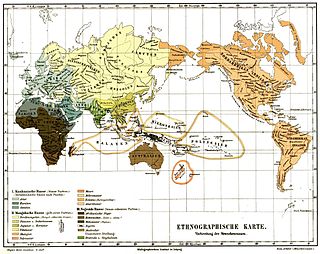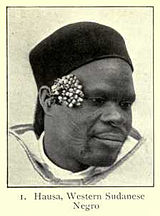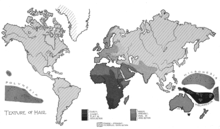Negroid (also known as Congoid)
is a historical grouping of human beings, once purported to be an
identifiable race and applied as a political class by another dominant
'non-negroid' culture. The term had been used by forensic and physical anthropologists to refer to individuals and populations that share certain morphological and skeletal traits that are frequent among populations in most of Sub-Saharan Africa and isolated parts of South and Southeast Asia (Negritos). Within Africa,
a racial dividing line separating Caucasoid physical types from Negroid
physical types was held to have existed, with Negroid groups forming
most of the population south of the area which stretched from the
southern Sahara desert in the west to the African Great Lakes in the southeast.
First introduced in the early racial science and anthropometry of the 1780s by members of the Göttingen School of History, Negroid denoted one of the three purported major races of humankind (alongside Caucasoid and Mongoloid). Many social scientists have argued that such analyses are rooted in sociopolitical and historical processes rather than in empirical observation. However, Negroid as a biological classification remains in use in forensic anthropology. The term today is usually considered racist, along with the term it derived from, Negro.
Etymology
Negroid has both Latin and Ancient Greek etymological roots. It literally translates as "black resemblance" from negro (black), and οειδές -oeidēs, equivalent to -o- + είδες -eidēs "having the appearance of", derivative of είδος eîdos "appearance". The earliest recorded use of the term "Negroid" came in 1859. In modern usage, it is associated with populations that on the whole possess the suite of typical Negro physical characteristics.
History
Illustrations of "racial types" from Man, Past and Present (1899) by Augustus Henry Keane
In the 19th century, Samuel George Morton posited a "Negro Family", which he grouped with the Caffrian, Hottentot, Oceanic-Negro, Australian, and Alforian families.
Distribution of the races after the Pleistocene according to Carleton Coon
In physical anthropology the term is one of the three general racial classifications of humans — Caucasoid, Mongoloid and Negroid. Under this classification scheme, humans are divisible into broad sub-groups based on phenotypic characteristics such as cranial and skeletal morphology. Later iterations of the terminology, such as Carleton S. Coon's Origin of Races, placed this theory in an evolutionary context. Coon divided the species Homo sapiens into five groups: Caucasoid, Capoid, Congoid, Australoid and Mongoloid, based on the timing of each taxon's evolution from Homo erectus Positing the Capoid race as a separate racial entity, and labeling the two major divisions of what he called the Congoid race as being the "African Negroes" and the "Pygmies", he divided indigenous Africans into distinct Congoid and Capoid groups based on their date of ancestral origin rather than just phenotype.
Afrocentrist author Cheikh Anta Diop contrasted "Negroid" with "Cro-Magnoid" in his publications arguing for "Negroid" primacy. Grimaldi Man,
Upper Paleolithic fossils found in Italy in 1901, had been classified
as Negroid by Boule and Vallois (1921). The identification was obsolete
by the 1960s, but was controversially revived by Diop (1989).
In the context of the first peopling of the Sahara, there was a debate in the 1970s whether the non-negroid, mixed, or negroid fossils found in the region were older. Asselar man, a 6,400 year old fossil discovered in 1927 in the Adrar des Ifoghas near Essouk (now the Kidal Region of Mali), was claimed as the oldest known anatomically modern human skeleton of Negroid type.
Subraces
Illustration of Negroid, Caucasoid and Mongoloid skulls shown from above (Samuel George Morton, 1839)
In the first half of the 20th century, the traditional subraces of the Negroid race were regarded as being the True Negro, the Forest Negro, the Bantu Negro, the Nilote, the Negrillo (also known as the African Pygmy), the Khoisan (often historically referred to as Hottentot and Bushman), the Negrito (also known as the Asiatic Pygmy), and the Oceanic Negroids (consisting of the Papuan and Melanesian).
By the 1960s, some scholars regarded the Khoisan as a separate race known as the Capoid race, while others continued to regard them as a Negroid subrace. The term "Congoid" was frequently used interchangeably with "Negroid",
with the main difference being that Congoid excluded the Capoid taxon.
Physical features
Craniofacial traits
In modern craniofacial anthropometry, Negroid describes features that typify skulls of black people. These include a broad and round nasal cavity; no dam or nasal sill; Quonset hut-shaped nasal bones; notable facial projection in the jaw and mouth area (prognathism); a rectangular-shaped palate; a square or rectangular eye orbit shape; a large interorbital distance; a more undulating supraorbital ridge; and large teeth.
According to George W. Gill and other modern forensic anthropologists, physical traits of Negroid crania are generally distinct from those of the Caucasoid and Mongoloid races. They assert that they can identify a Negroid skull with an accuracy of up to 95%. However, Alan H. Goodman
cautions that this precision estimate is often based on methodologies
using subsets of samples. He also argues that scientists have a
professional and ethical duty to avoid such biological analyses since
they could potentially have sociopolitical effects.
Although widely used in forensic anthropology, some have also
challenged the accuracy of craniofacial anthropometry vis-a-vis
different human populations that have developed in close proximity to
one another and those of mixed ethnic heritage. Since the distinguishing racial traits are not set until puberty, they are also difficult to ascertain in preadolescent skulls.
Variation in craniofacial form between humans has been found to
be largely due to differing patterns of biological inheritance. Modern
cross-analysis of osteological variables and genome-wide SNPs has identified specific genes, which control this craniofacial development. Of these genes, DCHS2, RUNX2, GLI3, PAX1 and PAX3 were found to determine nasal morphology, whereas EDAR impacts chin protrusion.
Neoteny
Ashley Montagu lists "neotenous
structural traits in which...Negroids [generally] differ from
Caucasoids... flattish nose, flat root of the nose, narrower ears,
narrower joints, frontal skull eminences, later closure of premaxillary sutures, less hairy, longer eyelashes, [and] cruciform pattern of second and third molars". He also suggested that in the extinct Negroid group termed the "Boskopoids", pedomorphic traits proceeded further than in other Negroids.
Additionally, Montagu wrote that the Boskopoids had larger brains than
modern humans (1,700 cubic centimeters cranial capacity compared to
1,400 cubic centimeters in modern-day humans), and the projection of
their mouth was less than in other Negroids. He believed that the Boskopoids were the ancestors of the Khoisan.
Hair
Human hair texture distribution
Afro-textured hair
is tightly coiled, kinky hair. It is a ubiquitous trait among Negroid
populations. By consequence, the presence of looser, frizzly hair
texture in other populations has often been considered an indication of
possible admixture with Negroid peoples.
Commenting on the lack of body hair (glabrousness) of Negroids and Mongoloids, Carleton S. Coon wrote that "[b]oth negroid and mongoloid skin conditions are inimical to excessive hair development except upon the scalp".
Skin pigmentation
Skin pigmentation in Negroid populations varies from very dark brown to light brown.
As dark skin
is also relatively common in human groups that have historically not
been defined as "Negroid", including many populations in both Africa and
Asia, it is only when present with other typical Negroid physical
traits such as broad facial features, Negroid cranial characteristics,
large teeth, prognathism, afro-textured hair and neoteny, that it has
been used in Negroid classification.
Populations with frequently dark skin yet on the whole lacking the
suite of Negroid physical traits were thus usually not regarded as
"Negroid", but instead as either "dark Caucasoid" (e.g. Hamitic/Ethiopid and Arabid) or "Australoid" depending on their other salient physical attributes. By contrast, populations with relatively light skin yet generally possessing typical Negroid physical characteristics, such as the Khoisan, were still regarded as "Negroid".
Criticism
The term "Negroid" is still used in certain disciplines such as forensic and physical anthropology. In a medical
context, some scholars have recommended that the term Negroid be
avoided in scientific writings because of its association with scientific racism. This mirrors the decline in usage of the term negro in English, which fell out of favor following the campaigns of the Civil Rights Movement, but was later re-introduced in the US Census of 2010 because it was found that members of the older generation of African Americans continued to identify with it. The Oxford Dictionaries
website as of 2018 indicates that "the term Negroid belongs to a set of
terms introduced by 19th-century anthropologists attempting to
categorize human races(....) such terms are associated with outdated
notions of racial types, and so are now potentially offensive and best
avoided".
C.S. Coon's evolutionary approach was criticized on the basis
that such sorting criteria generally do not produce meaningful results,
and that evolutionary divergence was extremely improbable over the given
time-frames. Monatagu (1963) argued that Coon's theory on the speciation of Congoids and other Homo sapiens was unlikely because the transmutation of one species to another was a markedly gradual process.








